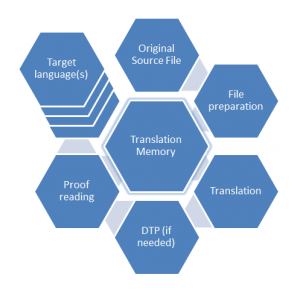This content has been archived. It may no longer be relevant

Analysis, file prep, translation and proofreading, content review, typesetting, and delivery?
Very good! During that tour, you had some questions and concerns about the process, and that’s totally understandable. Let’s look back and go over those now. I think your biggest concern was how we can speed up the timeline for a translation project, wasn’t it?
Yes, I’m on deadline on my end. If I need to shorten the timeline, how can we make that happen?
Well, none of the above stages can be eliminated, not if we want to maintain our level of quality. Yet there are steps that can be taken to speed the overall process, on your end and on ours.
One thing you can do is trim down the file preparation step, by getting us your files as near to translation-ready format as possible. If that old PDF is the only source you have, we can work with it, but it’s worth your while to make every effort to find the source document that PDF came from. We may still have to clean up a Word document, but compared to the PDF conversion/clean-up process, the file preparation will be minimal. Another thing: even if your text is a Word document, it may contain graphics with embedded text (i.e. part of a drawing or photograph). Translation management software won’t recognize this as text for translation, which means it’ll have to be extracted by hand. Extract the text on your end, and you won’t have to pay to have it done!

This is possible, yes. We adhere to the four-eyes principle (one translator, one proofreader), because more eyes on the text means more accuracy, and a wider net to catch any necessary changes. Also, having one translator translate the whole text ensures consistency in word choice and tone of voice. This is why allowing the time for a single translator to complete all the work is a good idea. But we can speed this up – what we would do is divide up your text as naturally as we could (we might divide a manual translation up by chapter, for example), and assign each portion to a different member of an assembled translation team. By dividing an 18,000-word translation among 3 translators per language, we could shave a 9-day translation turn-around down to 3 days. The use of our CAT tools and stored terminology would keep the voice consistent across the work of multiple translators. The whole translated document would still be attended to by a single proofreader per language, whose proofing duties would be expanded to include bringing the different translators’ choices into consistency with a common standard.
So that would cut a 14-day translation/proofreading stage down to 8 days? I like that!
We thought you would! Still, if we go this route, it’s an even better idea to plan for a review stage on your end, just in case.

Some of our clients do their own typesetting, based on bilingual tables we send them, and this can eliminate some of the cost. It can, but there’s no guarantee that it will. Typesetting a translation requires its own set of skills, more involved than firing up InDesign and spending a few hours copying and pasting. You can learn to do this, sure, possibly without great difficulty; just make sure that you know exactly what you’re doing before typesetting your own project, or you may need to have it professionally corrected in the end, anyway.
For this hypothetical manual project, we would advise against doing your own typesetting. Why? Because two of your six languages use non-Latin characters. Are you prepared to check Arabic script and Japanese kana for proper placement of punctuation, line breaks, and so on? Do you know what can and can’t be adjusted in formatting? You’ve also got Vietnamese on your language list. Of all the languages we deal with, Vietnamese is the most complicated to typeset, even though it uses the Latin writing system. With all of those accents, diacritics and special formatting needs, there are too many potential pitfalls for a non-professional typesetter to encounter. Best to let the pros handle this one!

As a matter of fact, we can. If your business forecast includes further translation projects (you’ll probably have to update that manual, right?), we invite you to take advantage of our online language portal. Once we set you up as a user and provide your login information, you can connect to our system via our website 24/7/365; you’ll see the button on the right of the homepage, just under the orange box where you can request a quote by e-mail. Through the portal, you can upload your documents for translation directly into our system, along with any special notes or requests you’d like us to bear in mind as we prepare the quote. And at any time, from the quoting stage right up to delivery, you can use the portal to monitor the status of your project, and its progress.

No, but you can contact us! Specifically, you can contact your project manager. Every project we deal with has its own dedicated project manager, who will be the designated liaison for all communication between you and your project’s translation team. It’s easier to cut down on miscommunications this way, and ensure that everyone involved with the project is on the same page. As an added bonus, every one of our project managers is fully bilingual in at least one language pair – depending on your project’s target language, you may also be getting a third pair of eyes to check your text at no additional cost to you!
You said something earlier about a translation memory… do I have one of those, now that my manual has been translated and proofed?
Yes, you do, and the next time you come to us with a translation project, if any text from that document has already been translated in this one, more likely than not, matches and repetitions will lead to a discount for you. Your translation memory grows with every project – work with us project after project, and your quotes will become more and more affordable over time.
The above hasn’t even touched on project types like software localization, website localization, dubbing, subtitling, or any of our interpretation options. If you have questions about any of these, or would like to see them explored in a future blog, leave a response in the comments, or contact us by telephone or e-mail. We’d love to hear from you!

